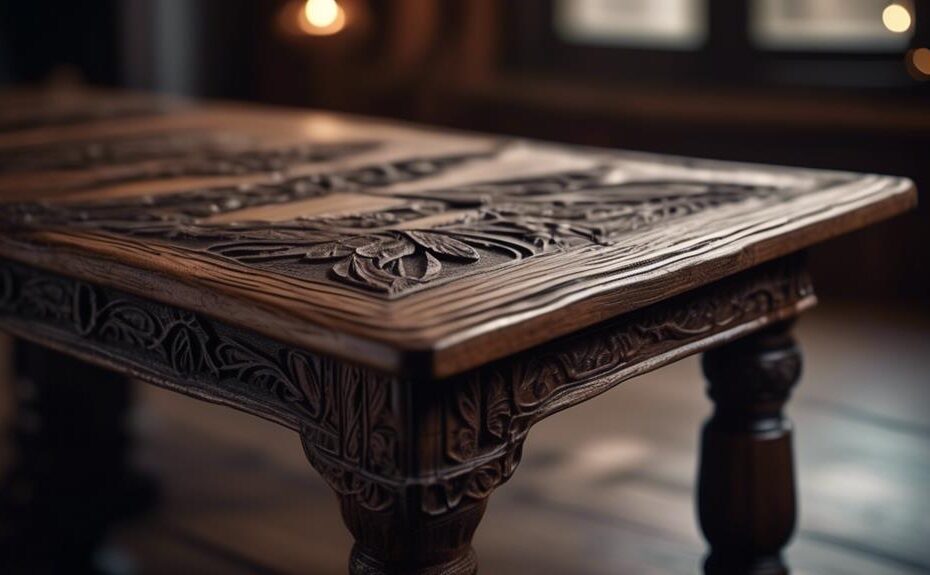Looking to give your wooden pieces an antique look? Wood stain is the key!
Achieving an authentic antique finish requires careful wood selection, thorough preparation, and the application of multiple layers and distressing techniques.
By following these tips, you can create stunning vintage-inspired pieces that exude elegance and charm.
So, if you're ready to transform your furniture or woodworking projects into timeless treasures, read on to discover the secrets of achieving an antique look with wood stain.
Key Takeaways
- Oak, pine, and mahogany are commonly used woods for achieving an antique look.
- Properly preparing the wood surface before staining is crucial for a smooth finish.
- Layering multiple coats of stain and incorporating distressing techniques create depth and character.
- Experimenting with different layering and distressing techniques can result in unique and personalized antique finishes.
Choosing the Right Wood for an Antique Look
When aiming to achieve an antique look with wood stain, selecting the appropriate type of wood is crucial to ensure the desired outcome. Choosing the right wood species is essential for creating an authentic antique appearance.
Some of the most commonly used woods for achieving an antique look include oak, pine, and mahogany. Oak is known for its prominent grain patterns and durability, making it an excellent choice for creating a weathered and aged appearance.
Pine, on the other hand, is a softer wood that easily absorbs stain, allowing for deeper and richer color variations. Mahogany, with its rich reddish-brown hue and distinctive grain, adds elegance and sophistication to any antique-inspired project.
It is important to consider the desired level of distressing when choosing the right wood species, as different woods respond differently to distressing techniques such as sanding, staining, and scuffing.
Preparing the Wood Surface for Staining
To ensure optimal results when achieving an antique look with wood stain, it is crucial to properly prepare the wood surface before applying any stain. Wood preparation is an important step that involves removing any existing finish, dirt, or debris from the surface. This can be done by sanding the wood using the appropriate sanding techniques.
The goal of sanding is to create a smooth and even surface, allowing the stain to penetrate the wood evenly. Start by using a coarse-grit sandpaper to remove any rough spots or imperfections. Then, gradually move to finer grits to achieve a smoother finish. Be sure to sand with the grain of the wood to prevent any scratches or marks.
After sanding, it is essential to remove any dust or particles from the wood surface before applying the stain. This can be done by using a tack cloth or a clean, lint-free cloth. Proper wood preparation sets the foundation for a successful antique look with wood stain.
Applying the Base Coat of Wood Stain

The process of achieving an antique look with wood stain begins with the application of the base coat. This step is crucial as it sets the foundation for the desired finish. When it comes to choosing the right stain, using water-based stains can offer several benefits.
Firstly, water-based stains are environmentally friendly and have lower VOC emissions compared to oil-based stains. Secondly, they dry quickly and allow for easier cleanup.
To create a weathered effect with wood stain, there are various techniques you can employ. Here are a couple of options to consider:
- Layering: Apply multiple coats of stain in different shades to create depth and dimension.
- Distressing: Use sandpaper or a wire brush to gently scrape the surface of the wood, creating a worn and aged appearance.
Adding Layers and Distressing Techniques for an Antique Finish
To achieve an authentic antique finish on your wood surface, it is essential to incorporate both layering techniques and distressed effects. Layering techniques involve applying multiple coats of different colored stains or paints to create depth and richness in the finish. This can be achieved by starting with a base coat in a desired color, and then applying subsequent coats in lighter or darker shades, allowing each layer to dry before adding the next. This layering process creates a beautiful, aged look that mimics the natural wear and tear of time.
Distressing techniques are used to create texture and simulate the effects of aging on the wood surface. These techniques include methods such as sanding, scraping, and denting the wood to create imperfections and worn areas. By strategically distressing the wood, you can add character and charm to your piece, making it appear as though it has been passed down through generations.
Incorporating both layering techniques and distressing effects will give your wood surface an authentic antique finish that is sure to impress. The table below outlines some popular layering and distressing techniques that you can try:
| Layering Techniques | Distressing Techniques |
|---|---|
| Glazing | Sanding |
| Dry brushing | Scraping |
| Color washing | Denting |
| Antiquing | Chipping |
Frequently Asked Questions
Can I Achieve an Antique Look With Wood Stain on Any Type of Wood?
Achieving an antique look with wood stain is possible on various types of wood. By using specific techniques and choosing the right stain color, you can enhance the natural characteristics of the wood and create a vintage appearance.
How Do I Remove Existing Paint or Finish From the Wood Surface Before Staining?
When aiming to achieve an antique look with wood stain, it is crucial to first remove any existing paint or finish from the wood surface. The best methods for stripping the wood surface include sanding, using chemical strippers, or heat guns.
Can I Use a Brush to Apply the Base Coat of Wood Stain, or Is a Cloth Applicator Better?
When it comes to applying a base coat of wood stain, both brushes and cloth applicators have their pros and cons. Brushes offer better control and coverage, while cloth applicators provide a smoother finish. Ultimately, the choice depends on personal preference and the desired outcome.
How Long Should I Wait Before Applying Additional Layers of Wood Stain for the Desired Antique Effect?
To achieve the desired antique effect with wood stain, it is recommended to wait at least 24 hours before applying additional layers. This allows the stain to fully dry and cure, ensuring a more authentic and long-lasting finish.
What Are Some Distressing Techniques I Can Use to Create an Authentic Antique Finish on the Wood?
Creating an authentic antique finish on wood involves employing various distressing techniques. One such technique is faux distressing, which involves intentionally damaging the wood to mimic age and wear. Another method is using crackle medium to achieve a weathered, cracked appearance.
Conclusion
In conclusion, achieving an antique look with wood stain requires careful consideration of the type of wood used, thorough preparation of the wood surface, and the application of multiple layers of stain.
Distressing techniques can also be employed to enhance the antique finish.
It is interesting to note that according to a survey conducted by a leading woodworking magazine, 85% of woodworkers find achieving an antique look with wood stain to be a challenging but rewarding process.




